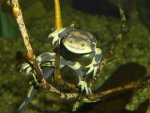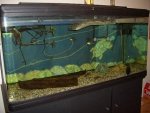Hilizanne
New member
- Joined
- Jul 23, 2015
- Messages
- 10
- Reaction score
- 0
- Points
- 1
- Location
- Amarillo, Texas
- Country
- United States
Hi I am new here. I apologize in advance if I am in appropriately in an advanced topic forum. I did read those rules but it is unclear to me which forums are "advanced".
I have frogs as pets mainly. I live in the Texas panhandle, and recently took a large number of tiger salamanders (barred) from someone who was selling them as bait. They are all young adults. I have since released most and given away many more and I kept 3. (I had about 140, and this was all local. These people were just netting them from their stream. It has been very wet here this year).
Anyway, I keep reading that tiger salamanders are terrestrial and bad swimmers. I do not find this to be the case at all. In fact, in the past and during this recent exposure to them I see them going to the bottom of the water and sort of tucking themselves under rocks. They seem to be excellent swimmers, tucking their legs under and moving their bodies much like a snake. When I released most on the shore of a small stream, several took off right down the middle, just like snakes. I have also tried the plantation soil that I have for my frogs, and they do bury down also. Of course then they are not visible and to me harder to feed.
So finally my question: do I have to provide dirt? Is it harmful to keep them mainly in an aquatic setup, provided I have a way for them to hide out of the water? I have read everywhere and I cannot find the answer to this. I do realize that in order to survive the winter, they do bury deep down in the soil. I know not to use gravel. Also, what about sand as substrate? It would be easier for a semi aquatic set up.
The smallest salamanders are 5 inches, largest were about 10 inches. I also kept them when I was a kid, only in water. But also only for the summer when school started, then I would release them. Maybe they prefer water during the spring/summer seasons only? Maybe I am over thinking this? I am setting up their habitat now and I want to do it right and not a second time. I really like seeing them not all covered in dirt all of the time. They are truly beautiful creatures. I also think they are very hardy. I mean I took over 140 of them, just piled on top of each other, kept them for several days in different buckets, none died. (Yet)
I have frogs as pets mainly. I live in the Texas panhandle, and recently took a large number of tiger salamanders (barred) from someone who was selling them as bait. They are all young adults. I have since released most and given away many more and I kept 3. (I had about 140, and this was all local. These people were just netting them from their stream. It has been very wet here this year).
Anyway, I keep reading that tiger salamanders are terrestrial and bad swimmers. I do not find this to be the case at all. In fact, in the past and during this recent exposure to them I see them going to the bottom of the water and sort of tucking themselves under rocks. They seem to be excellent swimmers, tucking their legs under and moving their bodies much like a snake. When I released most on the shore of a small stream, several took off right down the middle, just like snakes. I have also tried the plantation soil that I have for my frogs, and they do bury down also. Of course then they are not visible and to me harder to feed.
So finally my question: do I have to provide dirt? Is it harmful to keep them mainly in an aquatic setup, provided I have a way for them to hide out of the water? I have read everywhere and I cannot find the answer to this. I do realize that in order to survive the winter, they do bury deep down in the soil. I know not to use gravel. Also, what about sand as substrate? It would be easier for a semi aquatic set up.
The smallest salamanders are 5 inches, largest were about 10 inches. I also kept them when I was a kid, only in water. But also only for the summer when school started, then I would release them. Maybe they prefer water during the spring/summer seasons only? Maybe I am over thinking this? I am setting up their habitat now and I want to do it right and not a second time. I really like seeing them not all covered in dirt all of the time. They are truly beautiful creatures. I also think they are very hardy. I mean I took over 140 of them, just piled on top of each other, kept them for several days in different buckets, none died. (Yet)







